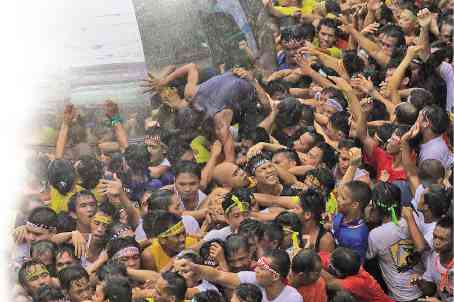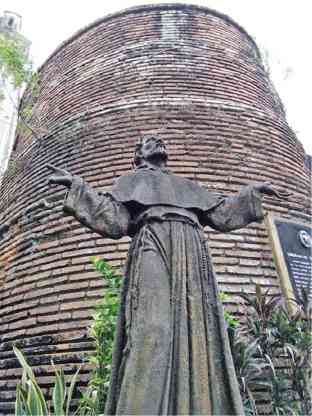Peñafrancia reminder of Bicol’s liberation

DEVOTION TO ‘INA’ The outpouring of faith and devotion to the Our Lady of Peñafrancia is shown at the “traslacion,” where devotees join a procession of the image of Ina in Naga City. MARK ALVIC ESPLANA
A highlight of the history of Naga City, a Camarines Sur settlement used to be known as Ciudad de Nueva Caceres, was the revolt against Spanish authorities that freed the natives from colonial rule on Sept. 18, 1898.
The liberation came at an auspicious time, on the feast day of the Our Lady of Peñafrancia, the patroness of the Bicol region.
Professor Danilo Gerona, a Bicol historian, said the revolt began with a rumor that the Spaniards were planning to use guardia civil (civil guards) to kill the principales (educated class). The plot would also include the killing of the civil guards after they accomplished their mission.
Gerona, who authored several books on Bicol history, spent six trips to Spain to research from the manuscript collections of Archivo General de Indias in Seville, and Archivos Franciscano Ibero-Oriental, Museo Naval, Real Academia de la Historia and Bibliotica Nacional de España, all in Madrid.
Blockade
Article continues after this advertisementGerona described that period in Bicol, when the American forces had imposed a blockade in Manila, as peaceful and calm except for the rising prices of prime commodities.
Article continues after this advertisementHe said the blockade did not have much impact on the region as Spaniards and Bicolanos went on their usual lives without disruption.
Trouble
But trouble began with the arrival of Don Carmelo Navarro, the commander of the civil guards of the Southern Luzon provinces.
Gerona said Navarro, who came from Albay province, conducted a series of meetings with all Spanish residents in preparation for any eventuality as the war with the Americans was turning unfavorable for the Spanish forces.
He said Navarro wanted the Spanish community in Cuidad de Nueva Caceres evacuated at once and join those in Albay. The plan, however, was met with resistance from the Spaniards themselves.
“Natives, who were observing the Spaniards, began to suspect the reasons behind these conferences. With Navarro there, the natives feared that a sinister plot was afoot. Then, rumors spread that the Spaniards were planning to use the civil guards to liquidate the members of the educated class and then the civil guards would in turn be liquidated,” Gerona said.
He said the fear gripping the civil guards heightened when Navarro reviewed the troops and ordered the disarming of volunteers.
“They (civil guards in Naga City) took these circumstances as confirmation of the rumor,” Gerona said.

HISTORIC CHURCH Remnants of San Francisco church in Naga City have been preserved to remind Nagueños about the role the city played in ending Spanish rule in the Bicol region in 1898. JUAN ESCANDOR JR.
Revolt
Led by two civil guards—Corporals Elias Angeles (a Tagalog) and Felix Plazo (a Bicolano)—the plot to revolt against the Spaniards in Naga was hatched since they believed it was the only way out of eventual death.
“They convinced all their native comrades of the necessity of this move in order to save themselves from imminent death. On Thursday, Sept. 15, 1898, the civil guards met and planned the details of the uprising, which was fixed on Sunday, Sept. 18, at midnight,” Gerona said.
He said through a woman, the plot was relayed to the natives in the neighboring towns of Naga.
After the Mass on the feast day of the Our Lady of Peñafrancia on Sept. 18, 1898, a parishioner, identified only as Capitana Dibang, informed the priests of the rumor going around the poblacion (town center) that the Spaniards would massacre the natives, Gerona said.
But Spanish authorities were quick to douse the rumors by holding a public announcement around Naga to deny existence of a plot to kill locals, he said.
“When the cathedral clock struck midnight, the first shot of the uprising was fired. This continued until early in the morning. The revolutionaries inflicted heavy casualties on the Spaniards,” Gerona said.
But during the revolt, he said, countless women were raped by hardened criminals who were freed from their cells when the revolt started.
Gerona said some 400 Spaniards and pro-Spanish Filipinos took refuge in San Francisco church to mount their last defense until Sept. 19, 1898.
The revolutionaries, headed by Angeles and Plazo, gave the Spaniards until 2 p.m. to surrender or they will attack and burn the church.
Gerona said representatives of the Spaniards met with the revolutionary leaders and the terms of surrender were presented.
He said the revolutionaries demanded that the Spaniards surrender their arms, issue official communications to the Spanish military in Daet town in Camarines Norte province to prohibit them to enter Nueva Caceres in a hostile manner, and for the governor to hand over his power to rule province to the revolutionaries.
Gerona said the revolutionaries allowed the Spaniards to return to their houses upon the surrender of their firearms.
“The successful revolt in Nueva Caceres, which brought the proud Spanish government to its end in [Camarines Sur], signaled the end of Spanish rule in the whole region,” he said.